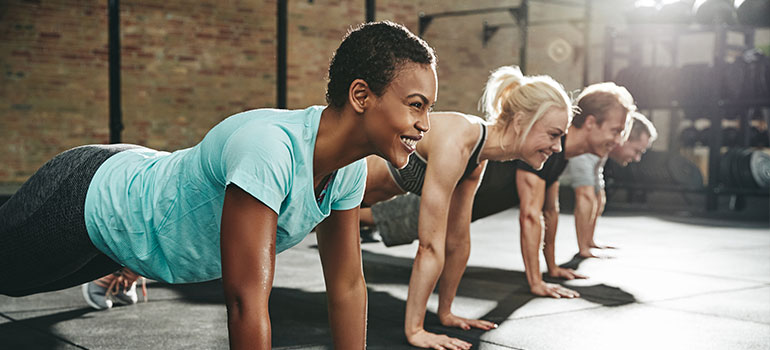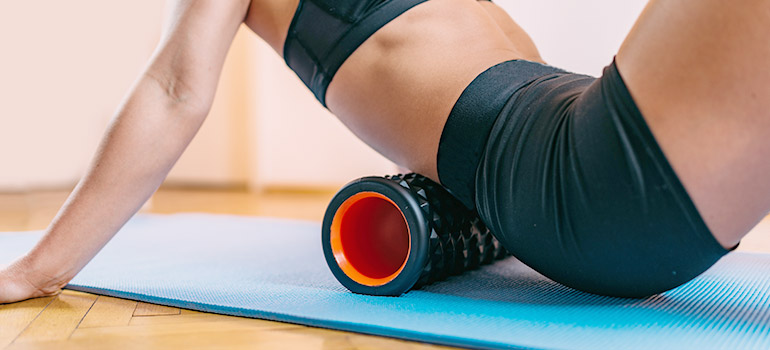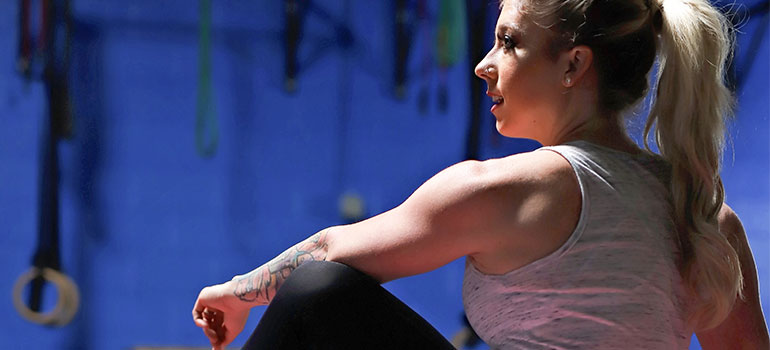Proper Push-up Technique Every Time, All the Time
Full disclosure: push-ups are hard for me. Like real, real hard. And, golly, I’ve been a personal trainer for over a decade now! So, if push-ups are hard for you too, you’re in good company.
I’m still working on upping my reps and you’ll often find me using modifications. Even though I struggle, I end each workout with complete confidence that I know how to do a proper push-up.
The wrong way to do a push-up
During my years of personal training and fitness instructing, I’ve seen hundreds, if not thousands, of bad push-ups. They come in all shapes and sizes, but I’ve narrowed down some of my favorites and given them names.
See if you recognize yourself in any of these examples below. Don’t be cheating yourself in your push-ups! And, even more importantly, don’t injure yourself with the following mistakes!
The drooping head

Don’t look so sad, girlfriend. Chin up! I see so many push-ups with drooping heads. It almost reminds me of bobbing for apples. Do you see it?
The sunken rib cage

Moving on down from the head, we come to the shoulder blades and the ribcage. The rib cage splays open and the shoulder blades “wing” off of the back when you succumb to the force of gravity. Let your torso show gravity who’s boss by pushing your entire body away from the floor. Give “the girls” a lift!
The saggy butt

No one wants a saggy butt, and, lemme tell ya, this is the mistake I see the most. Perk up that derriere! And, ouch, doesn’t it hurt your lower back just to look at this picture?
The hiked-up butt
I love that booty of yours. You’ve been doing the Booty Bootcamp, haven’t you? 😉 Kim Kardashian herself would be proud. But, your butt ain’t the star of the push-up. Keep it down, now.
The chicken wing arms

There is a common misconception that the elbows should go out at 90-degrees in a push-up. Nope. Push-ups in this position put a lot of shearing force on the shoulder joint. Yikes!
The halfsies

A push-up ain’t a push-up if you’re not going all the way down and all the way up. Those are halfsies, quarterlies, or maybe even sixteenth-lies.
The worm

The worm is one of my favorite dance moves. (Though, as I get older, I enjoy watching it more than I enjoy doing it.) This slick move is totally appropriate on a stage or in a dance circle. But a push-up, however, is not the time or place for a body roll.
The right way to do a push-up!
I’ve also come up with some names for the right way to do a push-up. Hopefully, they will help you remember these tips for proper pushup form:
Unicorn horn

To fight the drooping head, remember your “unicorn horn.” Think of yourself as a mighty unicorn. Point your “horn” out long in front of you. Don’t let it droop toward the ground.
Your spine is separated into five sections: tailbone, sacral, lumbar, thoracic, and cervical. Many folks don’t realize that the neck, the cervical section, is an extension of the spine. In a proper push-up, the spine will be lengthened from the top of the head down through the tailbone.
Hollow out your armpits
To keep your torso and “your girls” from sagging to the floor, think of hollowing out your armpits and pulling them away from the floor. Air out those pits out! Another way to fight the sag is to think of broadening your back by pulling your shoulder blades away from each other. This will help to engage your shoulder girdle and pull your shoulder blades into their proper place. Their proper place is on your ribcage as opposed to “winging” up.
The term for pulling your shoulder blades, aka scapulas, apart and forward onto your ribcage is “protraction.” The serratus anterior, named for its serrated appearance, is the muscle in charge of scapular protraction.

A scapular push-up variation can help to develop strength in the serratus anterior and shoulder girdle. You will maintain straight arms throughout. First, you allow your ribcage to lower and your shoulder blades to draw in toward each other. Then, you pull up your ribcage by protracting through your shoulder blades.
Bad dog
Think of a bad dog tucking its tail between its legs to fight the hiked-up butt and saggy butt. Your head, shoulders, hips, knees, and ankles should all be in alignment. Keep that booty in its proper place! Tuck your tailbone under slightly and really engage through your core to prevent sagging through the hips.

The push-up is, in fact, an excellent core workout. Squeeze your thighs together and squeeze your glutes to increase stability and fire into your core. Engaging the deep stabilizing muscles of your core, particularly the transversus abdominis for you anatomy fans out there, is necessary for your spinal and pelvic stability. An unstable, unsupported lower back in a push-up can lead to pain and injury.
Elbow pits forward
The set up for a proper push-up is hands a little wider than your shoulders, fingers spread wide open, with your elbow pits forward. Yep. Elbow pits. Keep those pits forward to keep your elbows pointed back about 45 degrees. This allows for a better shoulder position.

Another way to think about your arms and hands in your start position is to visualize that you’re screwing your palms outward into the ground. This will help to activate those serratus muscles mentioned above that work to externally rotate your shoulder blades as well as protract them.
Full Range of Motion
You want the full benefit from the push-ups you’re doing, right? Of course, you do! Then you’ve got to do a full push-up! A full range of motion will provide the best muscular activation and muscular balance through the major movers of the chest, shoulders, and arms. It will also build greater joint stability and overall better movement quality.

A full range of motion includes starting in your high plank and moving all the way down to a low plank, also known as Chaturanga in yoga. All the way down doesn’t necessarily mean chest down to the floor. Try to aim for a 90-degree bend through the elbows.
Moving plank
A push-up is not a complex movement — you’re simply going up and down. It’s holding everything else solid throughout the up and down motion that makes push-ups so difficult. Shoulder, core, and hip stability are required. So, if you struggle to hold a standard plank, push-ups will be a struggle. Look to the steps below for building strength for a full push-up.
Steps to build strength for a full push-up

The number one reason that people struggle doing push-ups correctly is that they don’t know how to activate all of the supporting muscles required.
Pete McCall of the American Council on Exercise (ACE) outlines the following progression in developing a foundation of strength for a full push-up.
Planks
1. Quadruped
The very first step in building up to a full push-up is to develop the proper strength in the wrists and shoulders. The quadruped position, a.k.a. down on all fours, with the wrists positioned under the shoulders and the knees directly below the hips, is an excellent place to start. In this position, you have the support of your lower body with your knees down as you build core and shoulder stability as you actively press away from the floor.
This is a static exercise, or isometric contraction, meaning there is no movement. Hold this position for 20 to 30 seconds for three or four sets.
2. Modified High-plank
As stated above, the push-up is nothing more than a moving plank. The high plank is basically the “up” position. Doing a modified plank, with either your knees on the floor or with your hands propped up on an incline, shortens the distance between your anchor (your hands) and your pivot point (your knees or your toes, respectively.) This results in less resistance and more support for you to develop strength.
This is another static exercise. Hold this position for 20 seconds, gradually working up to 45 seconds for three or four sets.
3. High Plank
It is necessary to have strength and stability in the high plank in order to perform a proper push-up. Practicing this position helps develop the wrist, shoulder, upper back, and core strength needed to maintain a stable body throughout the entire range-of-motion of the exercise.
Begin by holding this position for 20 seconds for three to four sets. Gradually work up to holding for 45 seconds.
Negative Push-ups
When you’re lowering yourself to the floor in a push-up, you don’t just drop to the floor. No thank you to broken noses. Your working muscles are lengthening while working as they fight against gravity to lower you safely. A lengthening contraction is called an eccentric contraction. Eccentric contractions generate a great amount of force. Practice this lengthening, lowering phase to develop strength in controlling the push-up movement through the entire range of motion.
1. Modified Negative Push-ups
Negative push-ups are essentially the opposite of push-ups. You don’t actually include the actual push-up phase. You are simply lowering your body down to the floor with control. You are effectively strengthening your muscles by working them in a lengthened position through an eccentric contraction.
Start in your modified high-plank position with either your knees on the floor or with your hands propped up on an incline. Keep your hands slightly wider than your shoulders. Slowly lower your body to the floor as you count to five. Once you reach the floor, you’ll get back up to the starting position in any way that feels comfortable to you.
Repeat this motion for two sets of 6 to 8 reps. Gradually add another rep or two until you can complete up to 12 reps with control. Work toward completing four sets of 10 to 12 reps.
2. Negative Push-ups
Negative push-ups are a step up from the modified negative push-ups. The movement is the same. The difference is that you won’t have the modifications—so you will be on your toes and have no incline.
Repeat this motion for two sets of 6 to 8 reps. Gradually add another rep or two until you can complete up to 12 reps with control. After you can successfully complete four sets, you’re ready to move on…
You’re Ready for Push-ups!
1. Modified Push-ups
Now that you’ve mastered the lowering down, you’re ready to push yourself back up. Full range of motion, here we go!
Start in your modified high-plank position with either your knees on the floor or with your hands propped up on an incline. Keep your hands slightly wider than your shoulders. Slowly lower your body to the floor and then push the floor away. You got this!
Start with two sets of 6 to 8 reps. Gradually progress to 10 to 12 reps and then start adding sets. Work toward three to four sets of 12 reps. Got it? Now it’s time to progress…
2. Full Push-ups
Congratulations!! You are ready for full push-ups!! To perform a full push-up, start in your high-plank. Set yourself up for success using the postural tips from above: Unicorn Horn, Hollowed Armpits, Bad dog, and Elbow Pits Forward. Before you begin lowering yourself down, squeeze your butt to increase stability. Lower yourself with control to a 90-degree bend, then push on up, Baby.
Start with two sets of 5 to 6 reps. Work toward 10 to 12 reps and continue to add sets.
You did it!
Whether you cranked out a set of full push-ups or held a quadruped position for 20 seconds, I want you to feel accomplished by your efforts and your output today. It’s so important that you build up to a push-up properly by developing appropriate stability and strength.
Respect your body and respect your limitations by modifying where appropriate. Join me as I do the same! We can be confident together that we know we’re doing our push-ups properly.























